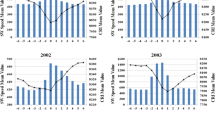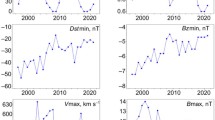Abstract
High-speed solar wind streams (HSWS) were identified for solar cycles 22 and 23 (up to 2004). Preliminarily, HSWS were classified in three groups according to their continuous period of occurrence. In the declining phase of solar cycle 23, 2003 is found to be anomalous, showing a very large number of HSWS events of long duration (> ten days). We have studied the effect of HSWS on the cosmic-ray intensity as well as their relationship with geomagnetic disturbance index Ap on yearly, daily, and hourly bases. The yearly average of solar-wind speed was also found to be maximum in 2003. Being within the declining phase of solar activity, the occurrence of solar flares in 2003 is quite low. In particular during HSWS, no solar flares have been observed. Associations with cosmic-ray changes do not support the notion that the HSWS are usually effective in producing significant cosmic-ray decreases. Out of 12 HSWS events observed during the period 2002 (December) to 2003, four events of significant cosmic-ray decreases at all the stations have been selected for further analysis. The cosmic-ray intensity has been found to decrease during the first phase of the event (first five days of HSWS) at all three neutron-monitor stations situated at different latitudes with different cutoff rigidities. The rigidity spectra of observed decreases in cosmic-ray intensity for these four cases have been found to be significantly different than that of Fds (Forbush decrease). In two cases the spectra are softer, whereas in the other two they are harder than that of Fds. However, if the average of all four events is considered together then the spectra of the decrease in cosmic rays during HSWS exactly match that of Fds. Such a result implies that initially individual events should be considered, instead of combining them together, as was done earlier. The Ap index is also found to generally increase in the first phase of the event. However, the four events selected on the basis of cosmic-ray decrease are not always associated with enhanced values of the Ap index. As such, the significance of our study is that further detailed investigations for much longer periods and on an event-by-event basis is required to understand the effect of coronal-hole-associated HSWS.
Similar content being viewed by others
References
Agrawal, S.P.: 1983, Space Sci. Rev. 34, 127.
Cane, H.V.: 2000, Space Sci. Rev. 93, 55.
Cane, H.V., Richardson, I.G., St. Cyr, O.C.: 2000, Geophys. Res. Lett. 27, 3591.
Jain, A.K., Pandey, P.K., Agrawal, S.P.: 1985, In: Proceedings of the 19th International Cosmic Ray Conference 5, 270.
Kane, R.P.: 1977, J. Geophys. Res. 82, 561.
Kumar, S., Jadav, M.P.: 2002, Ind. J. Radio Space Phys. 31, 190.
Mashi, A., Singh, M., Shrivastava, P.K.: 2004, Ultra Sci. 16(3), 309.
Mavromichalaki, H., Vassilaki, A., Marmatsouri, E.: 1988, Solar Phys. 115, 345.
Munakata, Y., Darwish, A., Fujii, Z., Kato, C., Mori, S.: 2003, In: Proceedings of the 28th International Cosmic Ray Conference, 3925.
Rangarajan, G.K., Barreto, L.M.: 2000, Earth Planet. Space 52, 121.
Richardson, I.G., Cane, H.V., Cliver, E.W.: 2002, J. Geophys. Res. 107, A8/1187.
Sabbah, I.: 2000, Can. J. Phys./Rev. Can. Phys. 78(4), 293.
Sabbah, I.: 2000, Geophys. Res. Lett. 27, 1823.
Sabbah, I., Rybansky, M.: 2006, J. Geophys. Res. 111, A01105.
Shrivastava, P.K.: 2003, In: Proceedings of the 28th International Cosmic Ray Conference, 3593.
Shrivastava, P.K., Jaiswal, K.L.: 2003, Solar Phys. 214, 195.
Shrivastava, P.K., Shukla, R.P.: 1994, Solar Phys. 154, 177.
Snyder, C.W., Neugebauer, M., Rao, U.R.: 1963, J. Geophys. Res. 68, 6361.
Tripathi, L., Shrivastava, A.K., Tiwari, A.K., Khare, A.: 2005, Ultra Sci. 19(1), A5.
Venkatesan, D., Shukla, A.K., Agrawal, S.P.: 1982, Solar Phys. 81, 375.
Author information
Authors and Affiliations
Corresponding author
Rights and permissions
About this article
Cite this article
Tripathi, L., Tiwari, A.K. & Agrawal, S.P. Study of Cosmic-Ray Intensity Variations Associated with Anomalous, Long-Duration High-Speed Solar Wind Streams in 2003. Sol Phys 241, 171–184 (2007). https://doi.org/10.1007/s11207-006-0256-5
Received:
Accepted:
Published:
Issue Date:
DOI: https://doi.org/10.1007/s11207-006-0256-5




